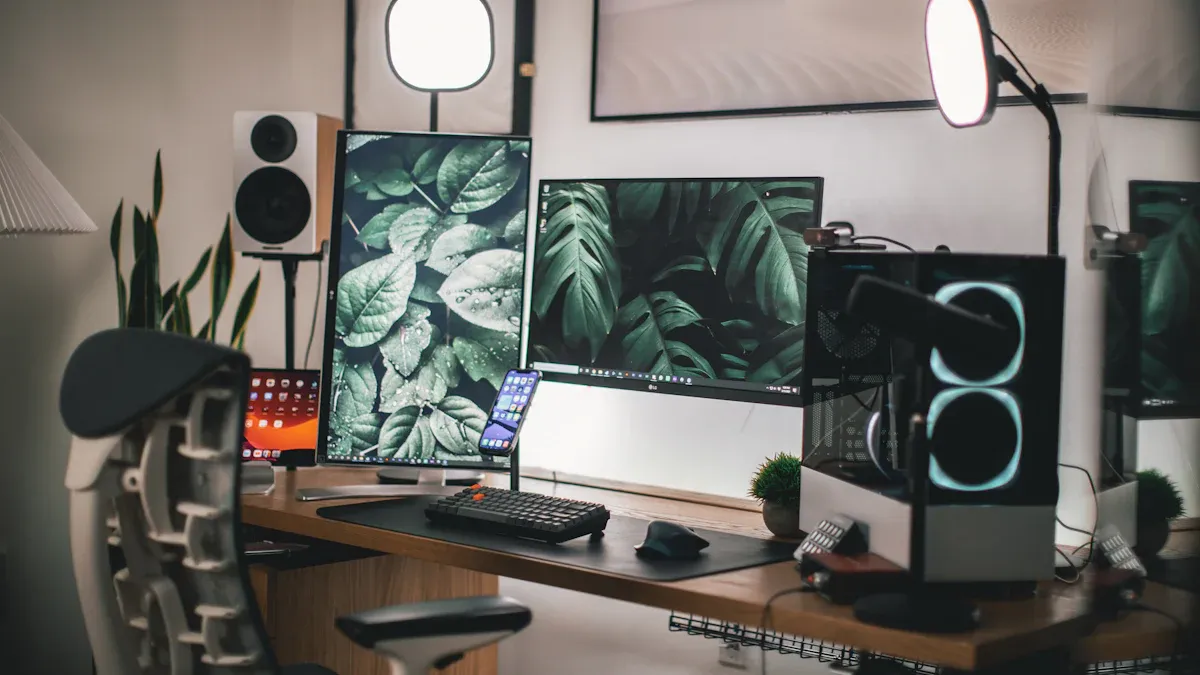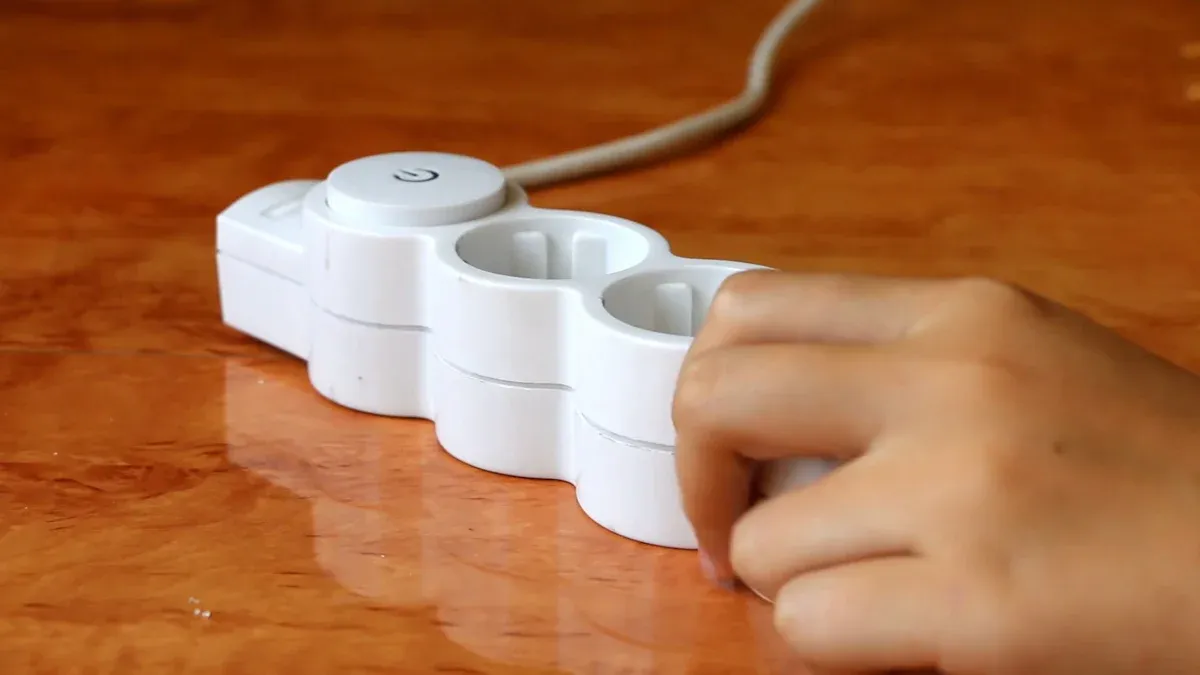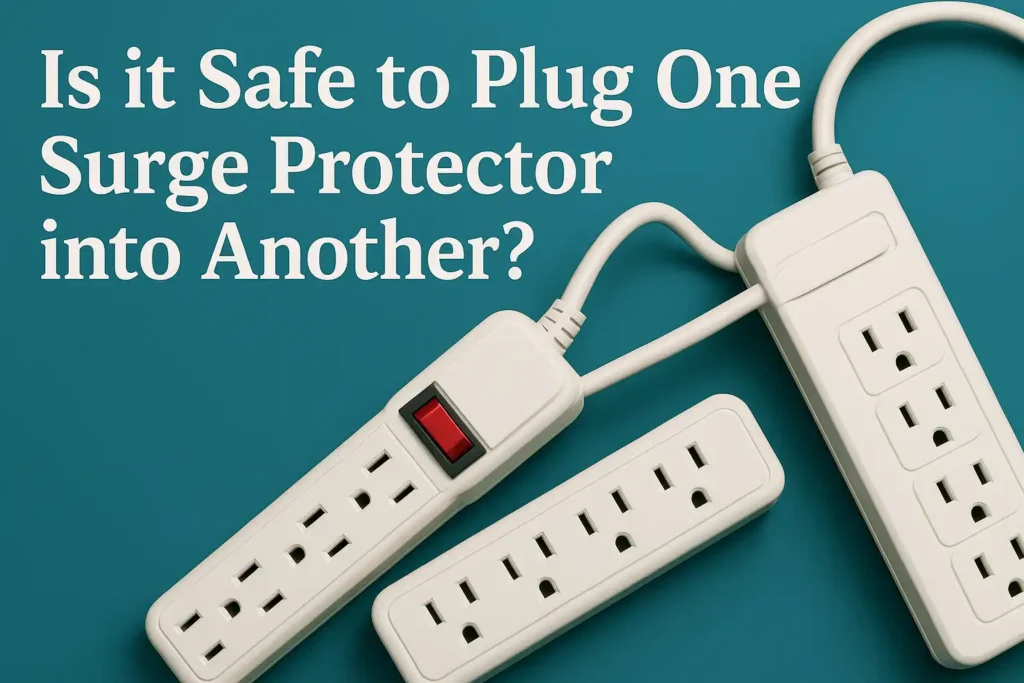No, you should not plug a surge protector into another surge protector. This can be dangerous for you. It can cause fire hazards or too much power use. Your devices may also get less protection. Every year, many fires start from cords and power strips. Here are some numbers:
| Statistic / Scenario | Value / Description |
|---|---|
| Fires linked to electrical cords (2010-2014) | 3,070 fires |
| Deaths from these fires | 110 deaths |
| Injuries from these fires | 230 injuries |
| Percentage of respondents using power strips | 92% (327 out of 357 respondents) |
| Typical power strip rating | 15 amps / 1,875 watts |
| Example device wattages plugged into one strip | Computer: 250W, Monitor: 190W, Speakers: 15W, Printer: 1,175W, Scanner: 150W, Desk lamp: 40W |
| Total wattage in example scenario | 1,820 watts (close to overload and fire hazard) |
| Common misuse leading to fire risk | Overloading, daisy-chaining, plugging high-wattage devices |
You may think you get more outlets this way. But it actually makes things more risky. Many people make this mistake. Always check your setup and put safety first.
Key Takeaways
- Do not plug a surge protector into another surge protector. This can start fires and harm your devices. If you connect surge protectors together, they can get too full. This makes the wires hot and can cause electrical fires. Plugging surge protectors into each other also makes them less able to protect your electronics from power surges. Use only one surge protector that has enough outlets for your needs. You can also upgrade your wall outlets for safer power. Check your surge protector often. Replace it if the protection light turns off or if it feels hot.
Surge Protector Risks

Fire Hazards
Plugging one surge protector into another can start a fire. When you connect them together, you create a chain that can overheat. The wires inside may get too hot. Sometimes, you might even see sparks. This is not just a small risk. Many fires in tall buildings start because of short circuits and overloaded wires. If the wires cannot handle the heat, they can catch fire fast.
Tip: Always check the fire resistance rating of your cords and cables. Some wires are safe, but others can be very dangerous if they get too hot.
Here’s a simple table to show how fire risk changes with different wiring and loads:
| Fire Resistance Rating | Risk Level | What It Means |
|---|---|---|
| High | Safe | Wires stay cool |
| Medium | Normal | Wires may get warm |
| Low | Dangerous | Wires can overheat |
| Very Low | Very Dangerous | Fire can start quickly |
If you use too many devices or chain surge protectors, you move from safe to dangerous very quickly.
Overloading
You might think you can plug in more devices by using two surge protectors together. This is not true. Each surge protector has a limit. If you go over that limit, you overload the circuit. When this happens, the breaker might trip or a fuse might blow. Sometimes, these safety features fail. If that happens, the wires can get too hot and start a fire.
Let’s look at what happens when you overload:
- The surge protector gets hot.
- The wall outlet gets hot.
- The wires inside the wall can melt.
- The risk of fire goes up.
You should always check the wattage of your devices. If you add up the numbers and they are close to the limit, you need to unplug something.
Reduced Protection
When you plug a surge protector into another, you do not get double the protection. In fact, you get less. The first surge protector might block a surge, but the second one will not work as well. The protection gets weaker. Your devices can get damaged if a big surge happens.
Note: Surge protectors are designed to work alone. Chaining them can confuse the way they handle surges. Your computer, TV, or game console could get fried.
If you want to keep your electronics safe, always plug your surge protector straight into the wall. Never chain them together.
Technical Issues
How Surge Protectors Work
You may wonder what happens inside a surge protector. Surge protectors have special parts called Metal-Oxide Varistors (MOVs). These parts act like guards for your electronics. When a sudden surge of electricity comes, the MOVs react fast. They lower their resistance and move the extra power away. This helps keep your computer, TV, or game console safe from harm.
Some surge protectors also use TVS diodes and TSPDs. These parts work even faster than MOVs. They stop voltage spikes before they reach your devices. Most surges last only a tiny moment, but they can still break your electronics. The surge protector’s job is to limit the voltage and send the surge away.
Here’s a quick look at how these parts work:
| Component | What It Does | How Fast It Works |
|---|---|---|
| MOV | Limits voltage to 3-4 times normal | Very fast (milliseconds) |
| TVS Diode | Clamps voltage to less than twice normal | Super fast (picoseconds) |
| TSPD | Breaks over to low voltage, handles big surges | Fast (microseconds) |
Tip: Surge protectors do not last forever. If the “Protected” light goes out, you should get a new one.
What Happens When Chained
Plugging one surge protector into another may seem helpful, but it causes problems. When you chain them, the surge protection parts do not work together well. The first surge protector usually takes all the damage. If it stops working, the second one cannot protect your devices.
Here’s what can go wrong when you chain surge protectors:
- Overloading can happen quickly, making wires hot and unsafe.
- The first surge protector may wear out faster, leaving you with no real protection.
- You might see the “Protected” light turn off sooner than you expect.
- Chaining can cause uneven signals, which may make your devices act strange or even break.
Many safety codes, like OSHA and UL, say you should never chain surge protectors. They warn that this setup can cause fire hazards and equipment failure. Checking your setup often and using only one surge protector per outlet keeps your home safer.
Safer Alternatives

If you want to keep your electronics safe, there are better ways than plugging a surge protector into another. Let’s see what you can do instead.
More Outlets
Sometimes you need more outlets for your devices. Instead of daisy-chaining, use one surge protector with lots of outlets. Some power strips and PDUs have up to 13 outlets and higher amp ratings. These help you avoid overloading and lower fire risk. Many have load monitors, so you know when you’re near the limit. Using one surge protector with enough outlets is simple and safe. Groups like OSHA and the National Electrical Code say this is best. It helps stop overloads and fire dangers from daisy chaining.
Upgraded Outlets
Upgrading wall outlets can make your home safer. New outlets have better insulation and built-in safety features. For example:
- GFCI outlets stop shocks and fires in kitchens and bathrooms.
- Circuit breakers and fuses protect from overloads and short circuits.
- Grounding and bonding keep electricity moving safely.
- New outlets often have barriers to stop accidents.
Older homes have more electrical fires, but new outlets help lower this risk. Studies show most electrical dangers start at outlets, so upgrading can protect your home and family.
Whole-House Protection
A whole-house surge protector shields your home from voltage spikes. These install at your main panel and handle small and big surges. They protect every circuit and device in your house. They cost more and need a pro to install, but they give long-term safety and peace of mind. Whole-house units handle big surges and often have lights or alarms to show they work. Many experts say to use both a whole-house protector and point-of-use strips for the best safety.
Tip: Always plug your surge protector right into a wall outlet. Do not daisy-chain to keep your home safe.
You should not plug a surge protector into another one. Doing this can make the wires too hot and start a fire. Here is what can happen if you chain them: The current can get twice as strong and melt cords very fast. More resistance makes heat and can hurt the wire covering. Sometimes, the fuses inside do not stop the danger, so things get risky quickly. There are safer ways to get more outlets. Use one power strip with enough spaces or get better wall outlets. Always look at your setup and pick the safest way. Keep your home safe by following these tips.
FAQ
What should you do if you already chained surge protectors?
Unplug them right away. Plug each surge protector directly into a wall outlet. Check for any signs of heat or damage. If you see melted plastic or smell burning, stop using them and replace them.
What devices should never go on a surge protector?
You should never plug space heaters, refrigerators, or microwaves into a surge protector. These devices use a lot of power. Plug them straight into the wall for safety.
What happens if your surge protector feels hot?
A hot surge protector means trouble. Unplug it and let it cool down. Heat can signal overloading or a wiring problem. Replace it if it keeps getting warm.
What is the lifespan of a surge protector?
Most surge protectors last three to five years. If you live in an area with lots of storms, you may need to replace them sooner. Always check the “Protected” light.
What is the safest way to get more outlets?
Pick a single surge protector with enough outlets for your needs. You can also ask an electrician to add more wall outlets. Never chain surge protectors to increase your outlet count.
The following information may be of interest to you
What Causes a Circuit Breaker to Trip Without Restoring Electricity
Can You Connect Multiple Surge Protectors Together Safely
How to Replace a Surge Protector Safely and Efficiently
Do you need a surge protector for your solar system



